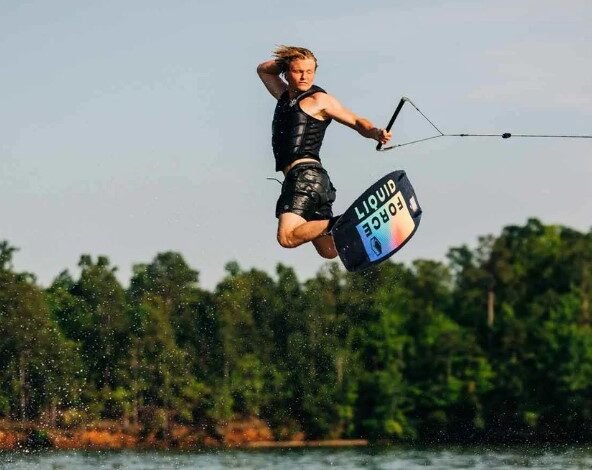Wakeboarding: The Ultimate Water Adventure

Wakeboarding is a thrilling water sport that combines elements of surfing, snowboarding, and water skiing. Whether you’re gliding smoothly across the water or performing heart-pounding aerial tricks, wakeboarding offers an unparalleled sense of freedom and adventure. In this blog, we’ll explore what makes wakeboarding so exciting, the gear you need, and tips to help you master this adrenaline-packed sport.
What is Wakeboarding?
Wakeboarding is a sport where a rider, attached to a boat or cable system by a tow rope, glides across the water on a board designed specifically for this activity. The sport, which emerged in the late 1980s, has grown into one of the most popular extreme water sports around the world. Unlike water skiing, which uses two skis, wakeboard uses a single board with bindings that secure the rider’s feet.
Riders can perform a variety of tricks, jumps, and turns while being towed, making it a dynamic and customizable experience. Whether you’re a beginner learning to balance or an expert executing flips and spins, wakeboarding has something for everyone. You can find the perfect wakeboard for your skill level at Barts Wakeboard Collection.
The Essential Gear for Wakeboarding
Before hitting the water, it’s crucial to have the right gear to ensure both safety and performance. Here’s a breakdown of the essential wakeboarding equipment:
Wakeboard: This is the most important piece of equipment. Wakeboards come in different sizes, shapes, and designs. If you’re a beginner, opt for a longer, wider board for better stability. Advanced riders usually prefer shorter boards that allow for sharper turns and easier tricks.
Bindings: Wakeboard bindings secure your feet to the board. It’s important to choose bindings that are comfortable and provide adequate ankle support. Most wakeboards come with adjustable bindings, but you can also invest in specialized bindings based on your riding style.
Tow Rope: The tow rope connects the rider to the boat or cable. For beginners, a shorter rope (55-65 feet) is recommended, as it provides more control. As you advance, a longer rope will give you more freedom for tricks.
Life Vest: Safety is key in wakeboarding. A Coast Guard-approved life vest should always be worn to ensure you stay afloat if you fall into the water.
Helmet (optional): Although not mandatory, a helmet is recommended for wakeboarders performing advanced tricks or riding in areas with obstacles.
For all your wakeboarding needs, you can explore the Barts Wakeboard Collection to find the best gear.
How to Start Wakeboarding
Starting wakeboarding might seem intimidating, but with the right approach and some practice, you’ll be riding the waves in no time. Here are a few steps to help you get started:
Body Position: Begin in the water with your knees bent and the wakeboard in front of you. Hold onto the tow rope with both hands, keeping your arms straight. The boat will gradually start to pull, and you should allow the boat to lift you rather than trying to stand up too quickly.
Let the Boat Do the Work: One of the biggest mistakes beginners make is trying to stand up too early. Instead, let the boat’s acceleration lift you naturally. Keep your knees bent and your weight centered over the board.
Balance: Once you’re up, focus on maintaining your balance. Keep your weight slightly back and your arms relaxed. Look ahead rather than down at your feet, and allow your body to follow the direction of your gaze.
Turning: To initiate a turn, simply lean on your heels or toes. Your body will naturally guide the board in the direction you want to go.
Keep Practicing: Wakeboarding takes time to master. Don’t get discouraged if you fall frequently—this is all part of the learning process.
For beginners, it’s essential to start slow and stay patient. With consistent practice, you’ll soon be riding like a pro. You can find beginner-friendly wakeboards and accessories at Barts Wakeboard Collection.
Advanced Wakeboarding Techniques
Once you’ve mastered the basics of wakeboarding, it’s time to move on to more advanced techniques. These tricks can take your riding to the next level, but they require practice and precision:
Ollie: The ollie is the foundation for many wakeboarding tricks. It involves lifting the board off the water without using the wake for height. To perform an ollie, shift your weight to the back of the board and then pop the board into the air by pushing down with your back foot.
Surface 180: This trick involves spinning the board 180 degrees while keeping it on the surface of the water. To execute a surface 180, initiate the turn with your shoulders and hips while keeping the tow rope low.
Wake Jump: Once you’re comfortable with riding the wake, you can start performing jumps. Approach the wake with your knees bent and arms straight. As you hit the wake, extend your legs and pull up on the tow rope to launch yourself into the air.
Grabs: Adding a grab to your wake jump makes it more stylish. A grab involves reaching down with one hand and holding the edge of your wakeboard while in mid-air.
360 Spin: The 360 spin is a full rotation in the air. As you approach the wake, initiate the spin by turning your shoulders and pulling the tow rope to your hip. Keep your eyes on the horizon to help with balance and landing.
Check out the Barts Wakeboard Collection for gear that can help you nail these advanced tricks.
Safety Tips for Wakeboarding
While wakeboarding is an exhilarating sport, safety should always come first. Here are some essential safety tips to keep in mind:
Always wear a life vest: Even if you’re an experienced swimmer, accidents can happen. Wearing a life vest ensures that you stay afloat in case you’re knocked unconscious or fatigued.
Use a spotter: Always have someone in the boat keeping an eye on the rider to alert the driver of any falls or mishaps.
Check your equipment: Ensure that your bindings, tow rope, and life vest are in good condition before you head out on the water.
Know your limits: Don’t attempt tricks that are beyond your skill level. Pushing yourself too hard can lead to injury.
Stay hydrated: Wakeboarding is physically demanding, so it’s important to drink plenty of water to avoid dehydration.
Find all the gear you need for a safe and enjoyable wakeboarding experience at Barts Wakeboard Collection.
Conclusion
Wakeboarding offers an exciting way to enjoy the water while pushing your physical limits. Whether you’re a beginner or an experienced rider, having the right gear and understanding the basics is key to success. As you improve your skills, you’ll find that wakeboarding opens up endless possibilities for tricks and stunts. For all your wakeboarding needs, from beginner boards to advanced gear, be sure to visit the Barts Wakeboard Collection and start your water adventure today.





